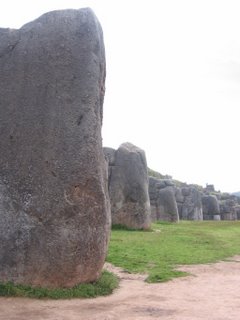City Valley Tour and Sacred Valley Tour - Cusco, Peru
We did tours of the city and Sacred Valley which included: Koricancha, thought to have been a temple to the Inca Sun God; Sacsayhuaman (sounds somewhat like, “Sexy woman”), built with massive quartz and granite blocks (up to 270 tones!) which is thought to have been an Inca fortress and/or temple; Qenqo, a sacred shrine; Tambochay, a sacred spring channelled through carved gutters and fountains built around 1500AD; Pisaq a large Inca town with an astrological centre and numerous irrigated terraces for researching crop farming; Ollantaytambo, an incomplete imperial Inca city/temple with water fountains, massive trapezoidal stones almost seamlessly joined together, agricultural terraces, storage buildings and a cliff that has the appearance of an Inca face; and Chinero, an old agricultural centre and market flanked by the snow capped mountains of the Chicon and Wequey Wilca with an old Spanish church.
We had only come to see Machupicchu but discovered that there are many majestic Inca ruins in the region around Cusco. Some were in the middle of the city, others much further away in the surrounding mountains. Meandering through the Andes on winding roads was reward enough, with incredibly scenic valleys and rivers separating huge lush green mountains with silver snow-capped crowns in the clouds. We would walk through the ruins and feel the ghosts of the past and wonder as to their lives.
The ruins are fantastic, steeped in history and myth. Because the Spanish systematically destroyed all symbols of the Inca religion and superimposed their culture on the Indians much of their civilisation remains a mystery, even though the high imperial Inca period was only in the fifteen hundreds. However, when you stand in the midst of the ruins, the mind’s eye takes you back in time: Inca elemental numen rise up from the granite rocks and crystal springs at the behest of feather adorned priests, richly decorated nobles rule from their palaces perched high in the mountains like eagles eyries and thousands of Inca peasants work the green terraced slopes and work their way along the Inca trials with antlike obedience.
During our tours of the city it was astonishing to learn how incredibly advanced the Inca were. Their stone buildings were exactly aligned with inclined walls and doors to resist earthquakes. They used tongue and grove fittings and bronze “staples” to ensure the granite blocks were joined seamlessly. They also had great skill in making ceramics, weaving, dying and mining and forging gold and bronze. When confronted by the Inca’s brilliant stone work, apparent organisation and seemingly impenetrable fortifications ensconced in the mountains, it is incredulous to hear that the empire of seven million people was conquered by a handful of Spanish Conquistadors in one year. The tale is mythic, with so many coincidences playing into the hands of the conquistadors: a civil war involving royal assassinations, the Spanish knights resembling images of Inca gods, divine providence during battles and a disenchanted “peasantry”.
Despite not having a written language, the Incas practised astrology and had a very complex religion involving the worship of a creator, the sun and the moon, the stars and the elements (particularly Mother Earth). In addition they practised ancestral worship burying their dead in caves and tombs facing the east. They had many festivals to honour and worship the dead and the former and current Incas (ie the Inca chiefs) had the status of gods (just like the pharaohs).
Ricky: “I guess Ancestral worship is easy to understand. All it takes is an undying love for ones parents. I loved and worshipped my Father immensely. While it is a cliché, for me, his passing was like an eclipse of the sun. I suspect that I will always gaze into the panoramic sunset of his memory, filled with warm colours and celestial thoughts, myself stranded in the lee of a great mountain, engulfed in the vast shadow of his absence. When I dwell on it, his passing still holds the wistful hooks of a thousand autumns. Our forefathers worshipped their ancestors by parading their bones. Elephants revere their dead by turning their giant bleached skeletons. The bones of saints were held in reliquaries as treasured relics. Likewise, I regularly fumble through the bones of my Father’s memory, desperately trying to summon his sub-conscious presence to shed light on a dark sea of alienation, and sometimes his moon-like presence rises above the inky swell. In these haunting hours, I try to commune with his lunar presence and whisper silent prayers, desperately hoping that my words will follow the trail of molten moonlight across the gulf-of-death. It must be greatly tempting to externalise these internal machinations and institutionalise the immortalisation and worship of one’s parents, even though reason would dictate that it is no more than reaching for the reflection of a stranded emotional desire or, worse still, a vain attempt to resurrect the dead. Modern thought is that we should let attachments to the dearly departed go, to drift away like autumn leaves in the breeze, but then who ever forgets the beauty of autumn leaves aflame, long after the winter winds have carried them away….










0 Comments:
Post a Comment
<< Home